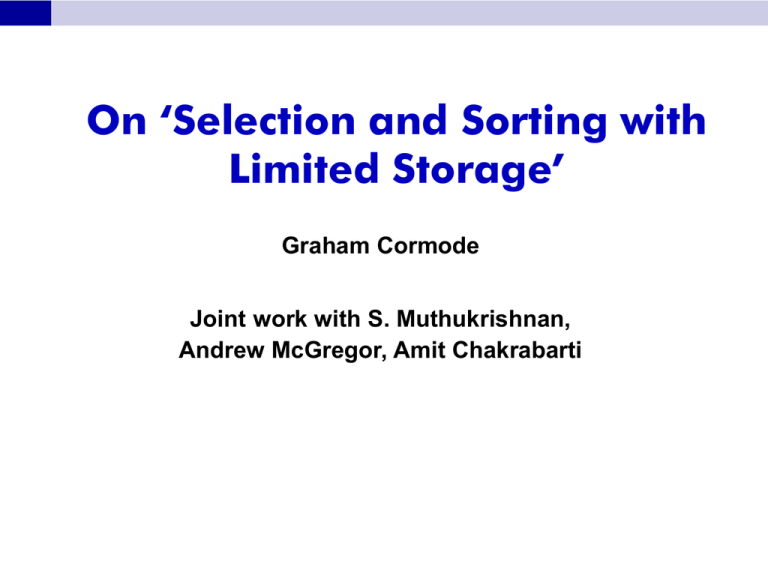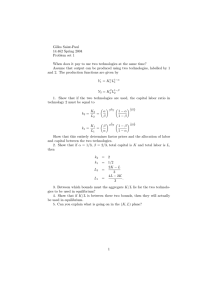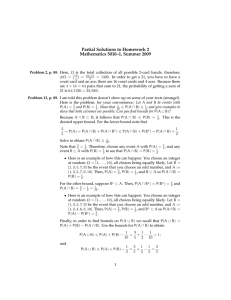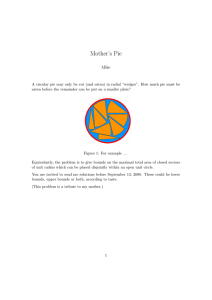www:
advertisement

On ‘Selection and Sorting with
Limited Storage’
Graham Cormode
Joint work with S. Muthukrishnan,
Andrew McGregor, Amit Chakrabarti
Mike Paterson
2
3
Munro-Paterson 78 [MP78]
One of the first papers to consider computing with limited
storage
–
Considered what could be accomplished in one or few
passes over input treated as a one-way tape
–
Storage sublinear in the size of the input
Effectively the now-popular ‘streaming model’
Focused on the problem of selection (median and
generalized median)
‘Selection’: Find the K’th ranked item (integer) out of N
– Dozens of papers on variations of these problems in the
streaming world in last decade
–
4
Results in MP78
P-pass deterministic algorithm for selection
–
In each pass, narrow down the range of interest
– Compute the exact ranks of a small range in the final pass
– Recursively merge and thin out pairs of buffers, tracking
bounds on the ranks of each retained item
– Gives O(N1/P poly-log(N)) space for P passes
Implies P=log N passes in poly-log(N) space
Revisited by Manku, Rajagopalan and Lindsay [1998]:
Obtain N error in ranks in O(-1log2N) space, one pass
– Improved to O(-1log N) by Greenwald and Khanna
–
5
Results in MP78
Deterministic lower bound of (N1/P) space for P-passes
–
Later, (1/) bound for one pass approximate selection
allowing randomness—implies (N) bound for exact
–
6
Based on an adversary who ensures that there are many
elements not stored whose relative ordering is unknown
Shown by Henzinger, Raghavan, Rajagopalan [1998]
Results in MP78
Bounds “assuming that all input orderings are equally
likely”
Now known as the “random order streams assumption”
Shows a problem is hard even under favourable order
– O(N1/2P) upper bound, and (N1/2) 1 pass lower bound
–
Guha and McGregor [2006] give a P=O(log log N) pass
algorithm for exact selection in O(polylog(N)) space
–
An exponential gap between the adversarial order case
– Resolves a question posed in MP78.
– Is this optimal?
7
Outline
8
Selection and Sorting with Limited Storage
One pass approximate selection with deletions
Lower bounds for P pass selection on random order input
Approximate Selection with Deletions
-approximate selection:
–
Find any item with rank between (Φ-ε)N and (Φ+ε)N
Streams with deletions:
Stream contains both “insertion” and “deletion” of items
– Assume no deletions without preceding matching insertion
– Captures e.g. database transactions, network connections
–
Assumption: items drawn from bounded universe of size U
–
Approach: solve a different streaming problem, then
reduce
–
9
Model as integers 1…U
Estimate frequency of some item j with additive error N
Count-Min Sketch
Simple sketch idea, can be used for as the basis of many
different stream analysis.
Model input stream as a vector x of dimension U
Creates a small summary as an array of w d in size
Use d hash function to map vector entries to [1..w]
Works on arrivals only and arrivals & departures streams
W
Array:
CM[i,j]
10
d
CM Sketch Structure
+c
+c
j,+c
hd(j)
+c
d=log 1/d
h1(j)
+c
w = 2/
Each entry in vector x is mapped to one bucket per row.
Merge two sketches by entry-wise summation
Estimate x[j] by taking mink CM[k,hk(j)]
Guarantees error less than ||x||1 in size O(1/ log 1/d)
– Probability of more error is less than 1-d
[C, Muthukrishnan ’04]
–
11
Approximation
Approximate x’[j] = mink CM[k,hk(j)]
Analysis: In k'th row, CM[k,hk(j)] = x[j] + Xk,j
–
Xk,j = S x[i] | hk(i) = hk(j)
–
E(Xk,j)
–
Pr[Xk,j ||x||1] = Pr[Xk,j 2E(Xk,j)] 1/2 by Markov inequality
= S x[k]*Pr[hk(i)=hk(j)]
Pr[hk(i)=hk(k)] * S a[i]
= ||x||1/2 by pairwise independence of h
So, Pr[x’[j] x[j] + ||x||1] = Pr[ k. Xk,j> ||x||1] 1/2log 1/d = d
Final result: with certainty x[j] x’[j] and
with probability at least 1-d, x’[j]< x[j] + ||x||1
12
Application To Selection
Impose a binary tree over the domain of input items
–
Keep a CM sketch to summarize each level of the tree
Estimate the rank of any item from O(log U) dyadic
ranges and estimate each from relevant sketch
For selection, binary search over the domain of items to
find one with the desired estimated rank
Result: solve one-pass -approximate selection with
probability at least 1-d using O(1/ log2 U log 1/d) space
–
13
Each node corresponds to the union of its leaves
Deterministic solution requires (1/2) space
Outline
14
Selection and Sorting with Limited Storage
One pass approximate selection with deletions
Lower bounds for P pass selection on random order input
Bounds Via Communication Complexity
Viewing contents of memory as a message being
passed, communication complexity techniques give
space lower bounds
–
Sending the contents of memory gives a communication
protocol
– Similar style of argument used in [MP78] to bound space
of a P-pass sorting algorithm
15
Proving lower bounds for streams in random order led us
to consider communication bounds for random partitions
of the input between players [Chakrabarti, C, McGregor 08]
The Model
2
5
6
16
... 21 23
1
8
8
... 24 24
0
0
0
... 25 25
The P players (Alice, Bob, Charlie…) each receive a
random partition of input (could be non-uniform)
Each communicates a message in order to the next,
in up to r rounds
Lower bounds on communication imply streaming
space lower bounds
Tree Pointer Jumping (TPJ)
f=3
f=1
f=0
17
f=1
f=0
f=0
f=2
f=1
Level 3
f=1
f=0
f=0
Level 2
f=1
f=1
Level 1
Instance: Function on nodes of P-level, t-ary tree,
– if v is an internal node: f maps v to a child of v
– if v is a leaf: f maps v to {0,1}
Goal: Compute f(f(... f(vroot)....)).
For P-players, if ith player knows f(v) when level(v)=i:
Any (P-1)-round protocol requires Ω(t/P2) communication.
– Even when input is picked uniformly at random
Reduction from TPJ to Median
11
22
18
3
4
55
66
88
0
2525 2525252525 2525 25
99
16
16
1717
17
24
7 10
13 14
21 22 23
23
10 11 12 13
14 15 18
18 19 20 21
With each node v associate two values (v) < (v) such
that (v) < (u) < (u) < (v) for any descendent u of v.
For each node: Generate more copies of (v) and (v)
such that median of values corresponds to TPJ solution.
Relationship between t and # copies determines bound.
– Need more copies higher up in tree
Simulating Random-Partition Protocol
β
19
α
β
α
β
α
α
β
Consider tree node v where f(v) is known to Bob.
Create Instance of Random-Partition Tree-Pointer Jumping:
1) Using public coin, players determine partition of tokens
and set half to and half to .
2) Bob “fixes” balance of tokens under his control.
The resulting distribution is “close” so algorithm expecting a
random partition should succeed with only slightly lower prob
Implications for Selection
P
Implies a communication lower bound of (N1/2 )
(supressing lesser factors)
Means any P-pass algorithm for median finding (more
P
generally, selection) requires (N1/2 /2P) space
–
poly(log N) space requires P=(log log N) passes
– 3 pass algorithm requires (N1/10) space
20
Conclusions
‘Selection and Sorting with Limited Storage’ continues to
be an influential paper, three decades later.
Several related papers accepted to SODA 2009:
–
Comparison-Based, Time-Space Lower Bounds for
Selection (Timothy M. Chan)
– Sorting and Selection in Posets (Constantinos Daskalakis,
Richard M. Karp, Elchanan Mossel, Samantha Riesenfeld
and Elad Verbin)
21






